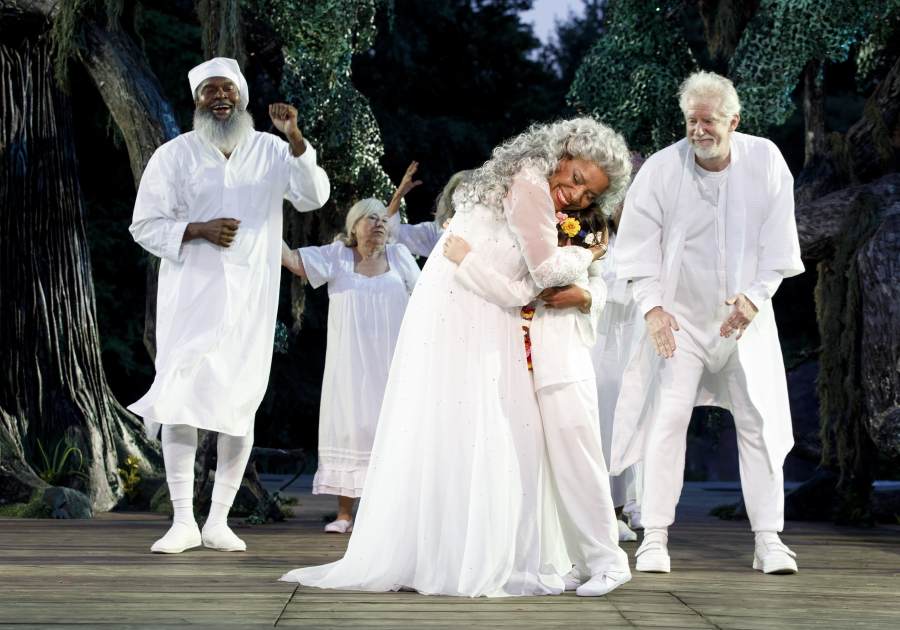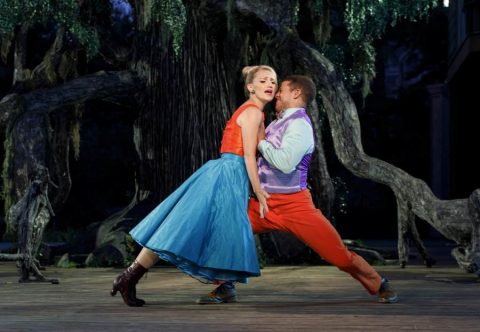

After its controversial, deeply serious production of Julius Caesar, The Public Theater's second Shakespeare in the Park production aims for light-hearted fun and fantasy. A Midsummer Night's Dream (directed by Lear deBessonet) captures all the magic of Shakespeare's beloved comedy, while simultaneously adding a few touches of its own. As the program notes, the Delacorte Theater in Central Park is the perfect setting for this Shakespearean romp through the woods, and since we're currently in midsummer, what time could be better?
Possibly the most delightful aspect of this production (apart from its wonderful cast) is Clint Ramos' bright, whimsical costume design. Theseus and Hippolyta's various costumes alone are jaw-droppingly spectacular, while the two sets of lovers dress in simpler outfits that hark back vaguely to the fifties -- in colors so bright they border on neon. Meanwhile, in a bold move, Ramos has clothed the fairy characters in white nightgowns and dressing robes (Puck wears striped pajamas). Combine this with the choice to cast all the fairies as elderly actors, and you end up with a dynamic that feels a bit like that of a nursing home crossed with a revivalist gospel meeting, complete with unusually energetic seniors who break out in random dance numbers. In the final scene, Ramos has dressed everyone in glittering flapper dresses and trim, dapper dress-suits. The fairies appear in shimmering black -- a change from their simple white nighties -- with Puck in a black suit reminiscent of a master of ceremonies or circus ringleader. Placed against David Rockwell's whimsical set of great mossy trees strung with twinkling lights (with a slide on one side of the stage and a tree-house on the other to house the on-point jazz band), Ramos' costumes color Shakespeare's vibrant comedy all anew.

But I'd be remiss if I didn't give equal credit for the vibrancy of this production to a cast of spirited actors, whose wide range of talents include natural delivery of Shakespearean dialogue, swing dance, and quasi-acrobatics. Shining brightest is Annaleigh Ashford's Helena, whose performance creates a quirky, melodramatic Helena from a character often played with much less charm. Shalita Grant's Hermia isn't far behind her, though: plucky, spirited, and fierce. And Danny Burstein is as enjoyable a Nick Bottom as you could wish for, while Kristine Nielsen turns out a nicely played performance as Puck, "that merry wanderer of the night."
Another especially thoughtful touch are the lighting and musical changes that accompany the play's moments of magic, adding a dreamlike sense of wonder to the action. In the end, that may be what's most delightful about this production: it perfectly captures the magic and wonder of Shakespeare's fantastic fairytale without following religiously the tropes of previous productions of the play. The result is that this performance comes off as both highly original and true in the most important ways to Shakespeare's script.
And as such, I won't be surprised if, with time, deBessonet's production comes to be remembered as a landmark staging of A Midsummer Night's Dream.